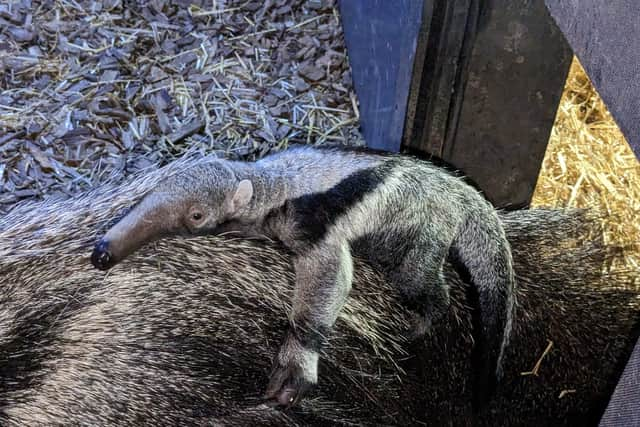Hidden cameras at Chester Zoo capture rare birth of giant anteater baby
and live on Freeview channel 276
Chester Zoo welcomed the newcomer as hidden cameras captured the birth of a baby giant anteater. The yet-to-be-named pup was born safely on the ground before climbing onto its mummy’s back only moments later.
The pup is only the third giant anteater to be born at the zoo in its 92-year history, and will spend the next 10 months on the safety of its mother’s back where their matching striped fur will keep the baby safe until it is ready to explore on its own. Born to 13-year-old Bliss and nine-year-old Oso, the baby is the result of a breeding programme aiming at preserving endangered species.
Advertisement
Hide AdAdvertisement
Hide AdDavid White, Team Manager in charge of caring for giant anteaters at the zoo, said: “Mum Bliss is so far doing an excellent job of looking after her new arrival and seeing the baby clinging on tightly to her back is a really special sight.
“Giant anteaters are truly fascinating animals. Despite their large size when fully grown, they feed mostly on tiny insects and can devour up to 30,000 ants or termites in a day. This diet of little invertebrates means they don’t have any teeth. Instead they use their sticky tongues to feed – these can reach two metres in length and can extend and withdraw at up to 150 times per minute.
“For the time being though, the baby is feeding from mum’s milk – crawling to her underbelly to suckle before climbing back around to rest on her back. The pup will take up this position for around 10 months as its matching fur helps keep it camouflaged, while also making mum look bigger and therefore more off-putting to would-be predators.”
Giant anteaters, which are native to Central and South America, are listed as vulnerable to extinction by the International Union for the Conservation of Nature (IUCN) on the IUCN Red list. White added: “With giant anteaters being vulnerable to extinction the birth is incredibly positive news for the species.
Advertisement
Hide AdAdvertisement
Hide Ad

“It’s a boost to the safety net population being cared for in conservation zoos like ours, while we’re continuing to learn more about them and, at the same time, create more awareness of the majesty of the species.”
Comment Guidelines
National World encourages reader discussion on our stories. User feedback, insights and back-and-forth exchanges add a rich layer of context to reporting. Please review our Community Guidelines before commenting.
